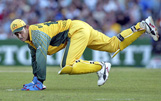COACHING
The Wicketkeeper's Wardrobe
Wicketkeeping is synonymous with a fair bit of 'wear and tear', considering that the 'stumper' is the busiest of the 13 players on the field. His teammates can afford to relax and 'take it easy' from time to time, but the wicketkeeper doesn't enjoy the same privilege. He is supposed to crouch, jump, run, and dive all the time, not to mention appealing and motivating his teammates! His hands, which are being 'battered' virtually every ball of the match, are especially vulnerable to injury. He catches the ball if the batsman leaves it alone, clasps edges that come his way, and collects returns from the fielders, some of which are quick, and 'stinging'.
Then, there is his back, one of the most critical
parts of a sportsperson's body. Constant crouching
and rising tends to take its toll. However, the use
of proper equipment and clothing, coupled with a
good technique, can reduce the risk of injury.
What should a wicketkeeper's wardrobe contain? Shoes, socks, trousers, pads, jockstrap, box, shirt, sweater (if required), inners, gloves, cravat, headgear and a woollen pad to cover the back.
What should a wicketkeeper's wardrobe contain? Shoes, socks, trousers, pads, jockstrap, box, shirt, sweater (if required), inners, gloves, cravat, headgear and a woollen pad to cover the back.
Brand-new wicketkeeping gloves should not be used. Lest the readers misunderstand, it needs to be clarified that they should be made 'supple' before use. This can be done by placing them on turf and pounding them repeatedly with a bat. Another method is to wear them and then thump the fist in the center of the other glove. This will help make them more flexible. It will become easier to wrap the fingers around the ball.
Regular wicketkeepers do not need to wet their inner gloves, as regular use makes them supple through the moisture secreted by the palms. However, occasional keepers, who may be doing the job once a week or fortnight, must wet the inners to prevent them from becoming completely rigid. To protect the fingers, the keeper should bind each finger-joint with Elastoplasts. If he suffers from bruised finger-joints, he should replace the Elastoplasts with electrician's tape. If the center of his hand gets bruised, he should place a piece of plasticine over the bruised area.
The shoes should be light to ensure free and unrestricted movement. They need not have heels, as there is no pressure on them when he is in action.
Woollen socks help cushion the feet and absorb perspiration. In fact, some keepers wear more than one pair to increase the cushioning effect and help 'sock up' the moisture, especially when it is hot and the surface is hard.
The keeper's trousers should have extra room around the backside, so that he can have freedom of movement.
A keeper should never take the field without wearing an abdomen guard. A cricket jockstrap with the pouch to keep the 'box' is an absolute must.
The leg-guards should be light and pliable. Nowadays, keepers wear knee-high pads. Unlike the past wherein they wore batting leg-guards, the modern wicketkeeping-specific pads are more comfortable, in that the keeper finds it easier to fling himself around and even upwards to intercept rising deliveries bowled by pacemen and 'take' wayward returns from the deep. The flipside is that these pads tend to expose the knees and lower part of the thighs when the ball is keeping low and the keeper is 'standing up' to medium-pacers. However, there are very few keepers who actually 'stand up' these days, even to bowlers who are not all that quick, and so there is very little chance of this happening.
The keeper's shirt should fit him perfectly. It should accommodate his moving arms and allow him to crouch comfortably. The shirt must fit neatly around the waist, so that it does not emerge 'untucked' from trousers whenever he jumps or dives. The shoulders should have plenty of room.
In chilly conditions, the keeper must wear a short-sleeved sweater. There is always the danger of the breeze cooling the perspiration on his back, which could lead to back trouble. To guard against this, the keeper could wear a square woollen pad on the back. The wool will absorb perspiration and prevent it from cooling.
When the heat is unbearable, a cravat knotted at the front will help the keeper avert the danger of sunstroke. The cravat also prevents perspiration from running down the neck. Many keepers are distracted by sweat on the neck. They mistake it to be a fly or insect and end up committing an error.
To protect his scalp from the sun, the keeper should wear a cap or floppy sun-hat. Nowadays of course, many keepers wear a helmet while keeping to spinners.
Wicketkeepers should be fastidious about their equipment. They have to, for only then can they think in terms of having a prolonged, relatively injury-free career!